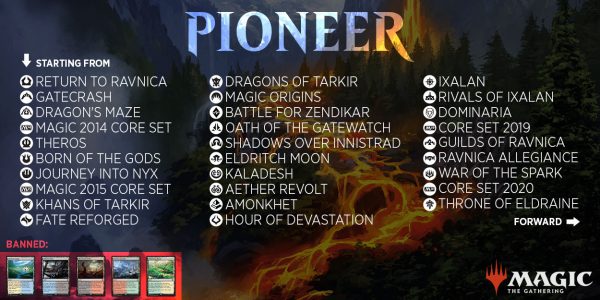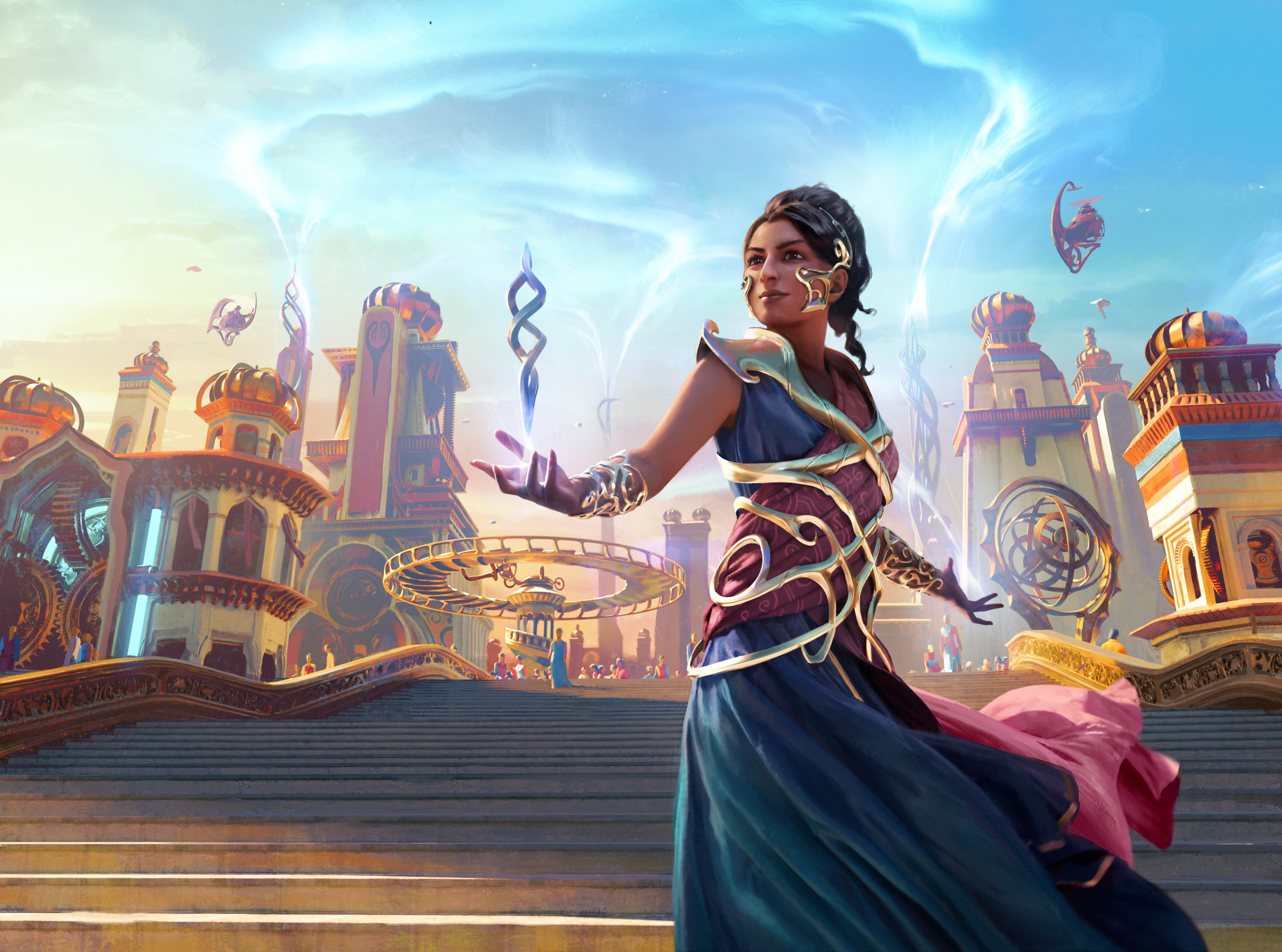Are you a Quiet Speculation member?
If not, now is a perfect time to join up! Our powerful tools, breaking-news analysis, and exclusive Discord channel will make sure you stay up to date and ahead of the curve.
Hey, all! Chroberry here back with my first proper article in a long while. As many Insiders may be aware, I've recently taken a more active role in some behind-the-scenes work at Quiet Speculation, which led me to take a break from articles and focusing more on our Discord, Trader Tools, and more. However, this crazy new(?) format has got me pumped to revisit some old favorites, and I'm excited to go over them with all of you.
The official announcement of Frontier Pioneer this Monday as Magic's latest non-rotating format has gotten players everywhere making mad scrambles for cards they know will be good in the new format. Much like the hype that ensued after Modern's inception in 2011, many cards stand out as frontrunners, as we've seen so many ludicrously powerful (and downright banworthy) cards dominate the metagame in their respective Standards.
This article will likely end up reading like a greatest hits list of the past seven or so years of Standard, but I promise you there will be some surprises at the end.

Lands, Lands, Lands
It's hard to start off talking about the format without first mentioning manabases, the keys to casting all of our powerful spells on time. Much like Modern before it, a vast majority of the mana bases that hold up Pioneer's early decks will start with the shocklands from the two Ravnica blocks that are legal in the format, and the checklands. What's significantly different this time around is the forced absence of fetchlands, the only initial bans for the format.
This will force many mana bases to be running full playsets of this land pairing, a marked difference from the usual two-shock two-check paradigm we usually see in Modern. Fetchlands aren't here to enable low shockland counts, so expect to be running approximately four of each, and likely far more basic lands than we're used to seeing in other Eternal formats. We can only hope this banning decision from Wizards contributes to deck diversity. It appears to be a good step in the right direction.
These are by far the most important cards to be picking up now if you're looking to start brewing in this format. If you don't have your 40 of each, I would consider making some fast trades and quick buys to get your hands on these early. Supply is high, but this sudden spike in demand will do a very good impression of the hype we saw during Modern's initial announcement, in a time period that was well before Return to Ravnica promised reprint of the cycle. Earlier is better.
While our shocks and checks are likely the most important, don't forget all the other untapped options we have access to in this format. Many have stated that the mana bases for three colors will be a bit rough, but not for total lack of support. This notion comes from the half-finished nature of some cycles, such as the Kaladesh fastlands and Core Set painlands only being in enemy colors. You'll probably be packing playsets of those as well, if your deck has access to them that is.
These aren't the only "playables" to keep in mind, though. Take the time to consider some of the other options to fill gaps in your mana base, such as the allied Battle for Zendikar tangolands, the allied cycling lands from Amonkhet, the Temples of Theros, and finally the reveal lands from Shadows Over Innistrad. These will not be super high-priority pickups in terms of cost, but should be something to keep in mind.
Before we move off the subject of lands, I should mention; it's probably no secret that Golgari-based decks will likely be the most powerful piles in the format's early days. For reasons I'll be outlining shortly, I'd prioritize picking up your Overgrown Tomb and Woodland Cemetery playsets to save yourself some extra dollars, as these may be more in demand than most of the others in those cycles. To add to that, I'll shoot my shot and say that Sultai will be the preferred "good-stuff" decks, as we have an insane amount of options in those colors to build powerhouse decks.
The Good Stuff
Most of the cards I'll be outlining here are my initial thoughts for being a distinct cut above the rest. We've got a lot of ground to cover, so I'll be moving quickly.
First and foremost, I will have to call out Thoughtseize to be what I consider the most powerful card by rate in this format. Its last appearance was format-warping and usually demanded four slots in every black deck during its life in Standard. Pound for pound, it doesn't really have an equal. To quote Ari Lax,
Would likely quit my day job if I always got Thoughtseize in Standard. Or quit Magic. Unsure which, honestly.
I'm sure no one is surprised to see Oko on this list. Oko is making huge strides in all the constructed formats it's legal in, and that trend will likely continue in Pioneer. We're about to get very tired of Oko's reign in Standard, and I wouldn't be surprised if this three-mana planeswalker makes its way on to the first banned-and-restricted announcement regarding this format. It is possible that the expanded card pool will balance out its relatively high power level, but I'm not seeing it from here just yet. It also fights Teferi, Time Raveler for space as being the most significant three-mana walker.
We'll likely see Bant lists pairing these two together to great success, and you can expect to see the value of this card to rise over time, as well. While definitely more oppressive to see across the table in some matchups, 3feri has a greater chance of surviving any initial bans and seeing significant growth in the next few months.
Speaking of ban-worthy cards, I have very little doubt that Aetherworks Marvel will make its way to that very same announcement. With the second iteration of the Eldrazi Titans legal alongside it (namely Ulamog, the Ceaseless Hunger), along with the full suite of energy cards from Kaladesh, I would be incredibly surprised if this artifact dodges that first wave of adjustments to the Pioneer. Attune with Aether turned out to be one of the biggest offenders representing the energy mechanic, and you may want to keep an eye out on that one as well.
As it turns out, the Kaladesh block has a ton of absolutely busted cards that may receive a quick ban. Again, I say that with very little testing of this format, but cards like Smuggler's Copter, Saheeli Rai, the Gearhulk cycle, and tons more have the potential to be overrepresented in Pioneer than many other sets. If you'd like a deeper dive on some of bigger cards from that set, I wrote an article about it some months back, still long after Frontier had well outstayed its welcome.
Pay particular attention to the lifespan of Felidar Guardian in this format, as it will be a big indicator of how willing Wizards is to let Pioneer have a powerful two-card combo deck. Obviously, we'll see a lot of players attempting to build decks around cards like Approach of the Second Sun and Nexus of Fate that have basically have the text "you win the game" on it, but the speed of those spells pales in comparison to what CopyCat decks will be able to do.
To Be Continued...
There is such a large swath of cards to go over, and I've only scratched the surface so far. Join me soon for part two, where I'll go over more of the hits, as well as some more off-beat choices that you may not have considered. Stay tuned!




